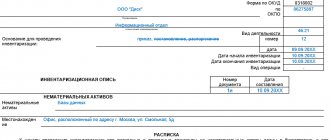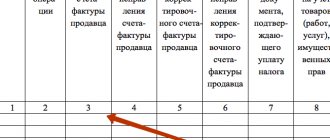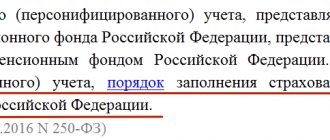⭐ ⭐ ⭐ ⭐ ⭐ Legal topics are very complex, but in this article, we will try to answer the question “An example of filling out an Inventory List for Material Reserves of Institutions Tonomny0504087 A.” Of course, if you still have questions, you can consult with lawyers online for free directly on the website.
The procedure for indicating information in these columns must be reflected in the accounting policies and regulations on the inventory of the institution. The updated inventory format fully complies with federal standards. Register 0504087 is necessary to record the results of the inventory of non-financial assets carried out in a budgetary institution.
Inventory list of non-financial assets (f. 0504087)
Each organization is obliged to conduct an inventory of non-fiscal assets in cases provided for by the accounting law 402-FZ. Additional checks may be provided for in the accounting policies.
We talk about form 0504087, reflecting the results of inventories, the scope of its application and the rules for filling it out. The inventory list f.0504087 was approved by Order of the Ministry of Finance 52n dated March 30, 2015 and should be used in all organizations in the public sector of the economy.
In Appendix No. 4 to this order you can download the form in Excel format for free. During the process of conducting an inventory of the NFA, the form is filled out by a commission, the composition of which is approved by order of the head.
The main purpose of the document is to identify discrepancies between the actual availability of fixed assets, MH, intangible assets and accounting data.
As of January 1, 2018, changes have been made to form 0504087 due to the entry into force of federal standards. Added columns:
- Gr.8 – for entering information about the status of the accounting object, its technical condition and involvement in economic turnover. Examples o, “not put into service”, “damaged”, “expired”.
- Columns 17 and 18 indicate the number and total cost of objects that do not meet the criteria for recognition as assets for accounting purposes.
- Gr.9 – for notes on the possibility of involving NFA in economic turnover or on methods of disposal. Examples: “commissioning”, “retrofitting”, “decommissioning”, “disposal”.
- Gr.10 – balance account number.
The updated document contains a large amount of information not only about the presence of NFA, but also about the organizational and technical state of the institution. Inventory list for objects of non-financial assets Filled out to document the results of the inventory for account 0.101.00.000.
Filled out to document the inventory results for account 106.11.
For unfinished items, indicate the construction stage and the target function code. Form 0504087 “Inventory List” consists of 4 pages.
The first one should indicate:
- Full name of the financially responsible person;
- location;
- date of completion;
- details of the order to appoint a commission;
- name of the institution, OKPO code;
- inventory start and end dates.
- structural subdivision;
Before the start of the check on this page, the MOL provides a receipt that all receipts and expenditure documents have been submitted to the accounting department, and that there are no written-off or received but not capitalized NFA at the storage location.
On the second and third pages there is a table that reflects the inventory results. For each NFA, the following fields are filled in:
- Name of the asset.
- Unit of measurement.
- Serial number.
- Number (inventory, nomenclature, accounting, etc.).
Columns 5-9 reflect information about the actual availability of accounting objects:
- Price or estimated value.
- Total amount.
- Quantity.
Statement of discrepancies (f. 0504092).
According to the updated provisions of Order No. 52n, the statement of discrepancies (form 0504092) should be compiled on the basis of inventory records (form 0504087) in order to summarize information about deviations identified during the inventory with accounting data. The indicators reflected in the statements and inventories are almost identical. The form also contains columns for providing information about accounting items for which it has been established that they do not comply with the conditions for recognition of an asset for accounting purposes. In addition, the appearance in the statement of a note from the accounting department indicating that the data has been accepted for accounting is considered an innovation.
Let's consider how the indicators are formed in the corresponding columns of the statement of discrepancies (form 0504092):
| Graphs | Filling procedure | Identical inventory indicators (f. 0504087) |
| Box 1 | Serial number | |
| Column 2 | Name of the non-financial asset item | Column 2 |
| Column 3 | Number (code) of the accounting object (inventory or other) | Column 3 |
| Column 4 | Unit | Column 4 |
| Box 5 | Accounting account number (code) | Box 10 |
| Box 6 | Book value (amount) per unit of accounting object | Box 12/box 11 |
| Column 7 | Price (estimated value) of the inventory item | Box 5 |
| Column 8 | Number of objects for which a shortage was identified according to accounting data | Box 13 |
| Column 9 | Shortage amount = column 8 x column 6 | Box 14 |
| Box 10 | The number of objects for which a discrepancy was identified within the limits of natural loss norms according to accounting data and actual availability | |
| Box 11 | The amount of objects for which a discrepancy was identified within the limits of natural loss norms = column 10 x column 6 | |
| Column 12 | Number of objects exceeding accounting data | Box 15 |
| Box 13 | Amount of surplus = column 12 x column 7 | Box 16 |
| Box 14 | Number of items that do not meet the asset recognition criteria for accounting purposes | Column 17 |
| Box 15 | The amount of objects for which it was established that they do not comply with the conditions for recognition of an asset = column 14 x column 6 | Column 18 |
* * *
Basically, the amendments determined by Order No. 194n affected the inventory forms (form 0504087) and statements of discrepancies (form 0504092). For the most part, they are aimed at ensuring that these accounting registers comply with the provisions of federal standards developed for public sector organizations: Conceptual Framework, Fixed Assets and Impairment of Assets. Please note that they should be followed starting in 2021.
Institutions must apply these forms in practice to the extent of their organizational and technical readiness, but no later than January 1, 2018.
Instructions for the application of the Unified Chart of Accounts for public authorities (state bodies), local governments, management bodies of state extra-budgetary funds, state academies of sciences, state (municipal) institutions, approved. By Order of the Ministry of Finance of the Russian Federation dated December 1, 2010 No. 157n.
Federal Accounting Standard for Public Sector Organizations “Conceptual Framework for Accounting and Reporting of Public Sector Organizations”, approved. By Order of the Ministry of Finance of the Russian Federation dated December 31, 2016 No. 256n.
Federal accounting standard for public sector organizations “Fixed assets”, approved. By Order of the Ministry of Finance of the Russian Federation dated December 31, 2016 No. 257n.
Federal Accounting Standard for Public Sector Organizations “Impairment of Assets”, approved. By Order of the Ministry of Finance of the Russian Federation dated December 31, 2016 No. 259n.
Instructions: fill out inventory lists
Not a day without instructions × Not a day without instructions
- Services:
An inventory list of goods and materials is a primary accounting document that is used to record the results of the inventory, namely the identified balances of fixed assets and other assets.
In the article, you will learn about the rules for filling out the document and can download a free inventory form for fixed assets and inventory items. February 25, 2021 Author: Sofya Ermakova First, let's look at the question of how companies inventory fixed assets and inventory items.
First of all, the corresponding order is issued. A unified form No. INV-22 has been developed for it, a form according to OKUD 0317018.
It contains the following information:
- basis for conducting an inventory.
- list of verified liabilities, property and fixed assets;
- name of company;
- composition of the inventory commission;
- structural subdivision;
- time and place of inventory;
Both fixed assets and assets owned by the organization, as well as fixed assets that had to be rented, are subject to inventory. The list is compiled in two copies.
The first is for the accounting service to draw up a reconciliation statement (if there are discrepancies with the accounting records). The second is for the financially responsible person (MRP).
When changing the financially responsible person, the inventory is drawn up in triplicate.
Before the start of the procedure, a receipt is taken from the financially responsible person that all documents have been submitted to the accounting department, therefore, accepted for accounting or written off as an expense. It is drawn up on a unified inventory form, at the bottom of the title page. No separate document is needed.
Form
“inventory list of commodity-material assets”
- this is a unified document No. INV-3 (form according to OKUD 0317004), approved by Resolution of the State Statistics Committee No. 88.
It is necessary during the inventory of materials, goods and finished products.
You can take an inventory of inventory items, and then we will tell you step by step how to fill it out correctly. We remind you that the inventory based on the results of the inventory of fixed assets is compiled separately. Step 1. Fill in the name of the organization, structural unit, OKTMO code, type of valuables, details of the basis document for the inventory.
Step 2. The financially responsible person certifies with his signature that all inventory items have been capitalized or written off. Step 3: In organizations where automatic data recording is carried out in specialized programs, form No. INV-3 is compiled using these programs.
They themselves fill out columns 1-9, and the commission notes in column 10 the presence of objects on the list. The commission determines the actual availability of inventory property, recalculating and reweighting it if necessary. It is prohibited to enter data on balances into the list from the words of the financially responsible person or according to accounting data, without checking their actual availability.
When is inventory taken?
A comparative inventory of material assets is mandatory when:
- Property for sale;
- The property is transferred for rent;
- The calendar period of the reporting type ends;
- The company's personnel policy is changing;
- Natural disasters have occurred;
- The enterprise is subject to liquidation or reorganization;
- Material values are appropriated.
The statement includes information regarding the surpluses and shortages available at the enterprise. It is compiled by the organization's accountant.
Inventory list 0504087 sample filling 2021
› New graphs have been added:
- 9—target function of the asset;
- 17 - the number of non-financial assets that do not meet the conditions for recognizing them as accounting objects, 18 - their amount.
- 10 - accounting account;
- 8 — status of the accounting object;
The procedure for indicating information in these columns must be reflected in the accounting policies and regulations on the inventory of the institution.
The updated inventory format fully complies with federal standards.
The following sections must be completed in the inventory:
- receipt;
- tabular part.
- introductory part;
The introductory part must indicate the place where the inventory was carried out, the details of the document that provides the basis for the inventory procedures (order, instruction), their deadlines, as well as a list of responsible persons. After entering the information in the header, the contractor must fill out a receipt, which notes that by the start of inventory procedures, all necessary documentation was provided to the accounting department confirming the receipt and expenditure of intangible assets.
It is important to remember that before starting the procedure, the institution should not have assets that are not accepted for accounting or written off as expenses.
- The unit of measurement is entered.
- Enter the name of the non-financial asset.
- Its inventory number (for inventory items) or code (serial number or information about the series, batch) is noted.
- New columns 17 and 18 record information about objects that do not meet the criteria for recognition as assets - their number (17) and amount (18). The total value is determined as follows:
- In column 10 the accounting account number is entered, in 11 - the quantity, and in 12 - the book value of the object.
- Columns 5–7 determine the estimated value or price of the inventory item, as well as its quantity.
- In columns 13 to 16, quantitative and monetary indicators of deviations are determined - shortages and surpluses.
- The fund number is indicated in order.
- New columns 8 and 9 indicate the status of the accounting object (the state of the property fund at the time of inventory procedures) and the target function (how to involve it in the financial and economic activities of the institution).
- Column 19 indicates comments - data that does not fall within the meaning of the previous cells of the table.
The storage period for an inventory list in a budgetary institution is at least five years.
In the document, in the details Type of NFA, select – fixed assets (rented). Let’s create a document for the example object “Equipment”. In edition 1 “1C: Accounting of a public institution 8”, the inventory of objects that are off-balance sheet is carried out using the document “Inventory of OS (off-balance sheet)” (menu “OS, intangible assets, legal acts - Inventory”).
In the document, select in the details “Type of NFA” - “Fixed assets” in use.
We will generate a document for the “Equipment” object. Inventory of settlements with the counterparty
Asset write-off
See what “Asset write-off” is in other dictionaries:
- Write-off - (write off) 1. Reducing the book value of an asset to zero. Leased equipment at the end of the lease period, obsolete machines or unsuccessful investments must be written off. 2. Reducing to zero the amount of debt that cannot... ... Financial Dictionary
- WRITTEN OFF — (write off) A decrease in the value of assets on the company’s balance sheets. Depreciation is the process of gradually writing off assets over time. The term write-off is also used in fairly serious accidents when the value of the relevant asset ... Economic Dictionary
- Write-off - (write off) 1. Reducing the book value of an asset to zero. Leased equipment at the end of the lease period, obsolete machines or unsuccessful investments must be written off. 2. Reducing to zero the amount of debt that cannot... ... Dictionary of business terms
- WRITTEN OFF - classifying an asset as a loss, removing it from the balance sheet, removing it from the balance sheet, reducing a balance sheet asset by a certain amount, for example, bad debts... Large accounting dictionary
- WRITTEN OFF - classifying an asset as a loss, reducing a balance sheet asset by a certain amount, for example, bad debts... Large Economic Dictionary
- depreciation, write-down, payment, repayment - An accounting procedure by which the original cost of intangible assets or assets that have a limited useful life is gradually reduced through periodic write-offs. Regarding fixed assets... ... Financial and investment explanatory dictionary
- Main directions of tax policy for 2009-2011. — Main directions of tax policy for 2009 2011. In accordance with the principles of medium-term financial planning, the Ministry of Finance of the Russian Federation in 2007 first developed a document defining conceptual... ... Encyclopedia of Newsmakers
- C - Balance Foreign trade balance State budget balance Trade balance see Foreign trade balance ... Economic and mathematical dictionary
- Asset - (Assets) Enterprise assets, current and non-current assets, accounting and asset management Information about enterprise assets, current and non-current assets, accounting and asset management Contents 1. Coefficient 2. Risky assets are in demand... Investor's Encyclopedia
- PBU 14/2007 - ACCOUNTING REGULATIONS ACCOUNTING FOR INTANGIBLE ASSETS (PBU 14/2007) Contents 1 I. General provisions 2 II. Initial assessment of intangible assets ... Accounting encyclopedia
Login for clients
Form INV-5. Inventory list of goods and materials accepted for safekeeping
2368 Form INV-5 is an inventory list of goods accepted for safekeeping in warehouse premises.
It is an important primary reporting document, confirmation of the delivery and receipt of material resources. The form is convenient in that it can be used to immediately compare data on the actual availability of inventory items in the warehouse and information regarding this availability in accounting.
FILES The inventory has several pages. The first is introductory, it contains a part with a receipt, the second and subsequent elements are presented in the form of a table.
At the conclusion, the signatures of the responsible persons are affixed. Fundamentally important points are indicated at the beginning. In the form of a small table on the far right side of the sheet, the form numbers according to OKUD, OKPO, the code of the type of activity of the organization, the document number and the date of its preparation, two dates: the beginning and end of the inventory are listed (even if it was carried out on one day, indicating both identical ones is mandatory), type of transaction performed and accounting account number.
The last two columns are filled in by the accountant after the signatures of the commission members and consideration by the manager.
We recommend reading: New amendments to the criminal code of 2021 under articles 158ch2
Also, separate lines are left for the full name of the organization (abbreviations to LLC, OJSC, individual entrepreneur, etc.) and the name of the division are acceptable.
The latter, in the vast majority of cases, is a warehouse under some serial number, since the INV-5 form is the most common in warehouse policy. Important point! At the top, the basis for the inventory must be indicated. This may be an order, notification or order from the head of the company as a whole or its division.
In any case, the inventory process must be carried out under the guidance and knowledge of the persons concerned. This fact must have documentary evidence.
On the first sheet of the document there is a receipt from the financially responsible person stating that by the time the inventory began, all the primary reporting documents necessary for this had been submitted to the accounting department, and goods and materials (inventory assets) had been capitalized and accepted for safekeeping.
Also, at the beginning of the verification process, all material resources written off from accounts must be indicated in the disposal papers.
It is undesirable for them to actually be in the warehouse itself to avoid misunderstandings. The receipt must also indicate the date of its signature and the deadline for removing the remaining material assets.
The information is very compactly placed in the table. Using the latter is extremely convenient.
The form was formed in the 90s, but still remains relevant.
The rows of the table are filled in as the actual availability of inventory items in the warehouse is compared with the data in existing documents. The columns must contain the following information: Row sequence number.
Name and OKPO code of the supplier or recipient. Nomenclature number of the product, its grade, type or group, full name. Storage location (usually the cell or location number is indicated).
Inventory list in the 2021 budget
- Inventory of fixed assets is carried out only once every 3 years. In the event of an emergency, an inspection is carried out immediately on that day or upon its completion. When appointing a new financially responsible person, the procedure should be completed before the dismissal of the old employee, usually on the day of transfer of authority. Shortages, theft, damage must be recorded strictly on the day this fact is established. Change of ownership, reorganization, lease.
- The composition of the commission indicating the positions of all employees participating in the event.
Name of the document (if not an order, then an order or resolution), start and end date of the inspection, number. Full details (name of the structural unit, if inventory items are located in it, OKPO code).
Reasons for the procedure. Elements of implementation – intangible assets, operating assets, obligations.
The timing of receipt of materials based on inventory results in the accounting department (matching statements, acts and inventories).
Thus, with regard to the printer subject to repair and landline telephones, the institution does not have sufficient grounds to recognize the objects in question as “not assets” and record them on off-balance sheet account 02.
Accordingly, these objects continue to be accounted for in the institution on the corresponding analytical accounts of account 101 00 “Fixed Assets”. According to Order No. 52n, column 8 of the Inventory List (f. 0504087) indicates information about the condition of the property as of the inventory date, taking into account the assessment of its technical condition and (or) the degree of involvement in economic turnover.
For fixed assets, the status may be indicated as “in operation”, “in need of repair”, “in conservation”, “does not meet operational requirements”, “not put into operation”.
The frequency of inventory is determined by the management of a particular legal entity. The inspection can be scheduled or carried out urgently. Inventory records of inventory items during a planned inventory are no different in form and content from those compiled during an unplanned inspection.
An inventory list of inventory items is a unified form of documentation drawn up when carrying out procedures for accounting for valuable property at a specific enterprise or organization.
The procedure for filling out the accounting inventory, the obligation to use it, the necessary details of the form are the main points that you must know in order to correctly record the inventory results. inventory number; date (it must be indicated twice - on the first line after the title and in the tabular section); name of the organization and structural unit where the inventory is carried out; surname, name, patronymic of the responsible person; number and date of the order to hold the event, as well as its location; start and completion dates of the inventory procedure.
The procedure for filling out the inventory list (forms INV-1a, INV-3)
Accounting documents Expand the list of categories Subscribe to a special free weekly newsletter to keep abreast of all changes in accounting: Join us on social media.
networks: VAT, insurance premiums, simplified tax system 6%, simplified tax system 15%, UTII, personal income tax, penalties We send letters with the main discussions of the week > > > September 10, 2021 All story materials An inventory list is a document without which no inventory can do. There are several varieties of this document - for each existing type of asset. And each form has its own form and its own specifics.
What this document is intended for and how it is drawn up will be discussed in this article. You can download some forms in completed form.
Documents and forms will help you: Inventory forms are approved by the Decree of the State Statistics Committee of the Russian Federation
“On approval of unified forms of primary accounting documentation for recording cash transactions and recording inventory results”
dated 08.18.1998 No. 88. At the same time, special forms of inventory lists (matching statements) were developed for state authorities, local self-government, management bodies of state extra-budgetary funds, state (municipal) institutions.
They were approved by order of the Ministry of Finance of Russia dated March 30, 2015 No. 52n.
For example, inventory form 0504087 is used to reflect the results of an inventory of non-financial assets carried out in an institution. The most commonly used types of inventory records are:
- inventory list of fixed assets (INV-1);
For information on the design features of INV-1, see
in the material.
- inventory inventory of intangible assets (INV-1a);
- inventory inventory of inventory items (INV-3 form);
- cash inventory act (INV-15);
Features of filling out INV-15 are disclosed in the material.
- act of inventory of receivables and payables (INV-17).
For information on the procedure for filling out INV-17, see
in the material. In this article, as an example, we will consider the procedure for filling out an inventory list for intangible assets and goods and materials. The inventory inventory form in INV-1 form provides information about the company’s intangible assets.
IMPORTANT! During the inventory, you should make sure that the object is correctly classified as intangible assets.
As a rule, 2 copies of the inventory list are compiled. The header records information about the timing of the inspection, as well as about the documents justifying the start of its implementation. After this, a receipt is provided on the receipt and write-off of intangible assets by the responsible persons.
Information on objects is entered into the tabular part of the inventory list in accordance with accounting data and actual availability.
In case of deviations of the fact from the accounting data, this is indicated in the inventory. Inventory list - example and
OS Statement
It is used to record information about fixed assets (real estate, devices of transmission-type machines and units, equipment for economic and production purposes, etc.). An inventory of assets is carried out subject to the presence of all members of the commission and the person with financial responsibility.
Our website allows for an inventory list, which will allow you to exercise control over the inventory assets of the enterprise. There is an example of filling out a document taking into account current requirements. The specialist will help you find samples of other documentation, advise on how to fill them out correctly and answer your questions. Using the provided search bar, you can quickly find the latest form you need.
Instructions: fill out the inventory list
Not a day without instructions × Not a day without instructions
- Services:
An inventory list is a document that is used to display the results of an inventory of non-financial assets.
We tell you how to fill out the form. January 13, 2021 Author: Alexandra Zadorozhneva The inventory list, or, as it is also called, the matching statement for non-financial asset objects, reflects the operational result of an audit in state and budgetary institutions.
The register has a unified form - OKUD 0504087 inventory list.
It was approved by Order of the Ministry of Finance of the Russian Federation No. 52n dated March 30, 2015. Since 01/01/2018, an updated format of the matching statement has been used, the form and rules for completing which are set out in Order of the Ministry of Finance of the Russian Federation No. 194n dated 11/17/2017. This is what the inventory list looks like, you can download the form (OKUD form 0504087) for free.
From January 2021, all public sector agencies are required to complete the updated form 0504087.
Moreover, not only the formal form of the inventory list has undergone changes, but also the rules for filling it out.
New graphs have been added:
- 8 — status of the accounting object; 9—target function of the asset; 10 - accounting account; 17 - the number of non-financial assets that do not meet the conditions for recognizing them as accounting objects, 18 - their amount.
The procedure for indicating information in these columns must be reflected in the accounting policies and regulations on the inventory of the institution. The updated inventory format fully complies with federal standards. Register 0504087 is necessary to record the results of the inventory of non-financial assets carried out in a budgetary institution.
At the end of the article you will see what a completed inventory list f 0504087 looks like; an example of filling it out for a budget institution can be downloaded for free.
The following sections must be completed in the inventory:
- introductory part; receipt; tabular part.
The introductory part must indicate the place where the inventory was carried out, the details of the document that provides the basis for the inventory procedures (order, instruction), their deadlines, as well as a list of responsible persons. After entering the information in the header, the contractor must fill out a receipt, which notes that by the start of inventory procedures, all necessary documentation was provided to the accounting department confirming the receipt and expenditure of intangible assets.
It is important to remember that before starting the procedure, the institution should not have assets that are not accepted for accounting or written off as expenses.
Next, fill out the tabular part.
In the updated register, the table has been supplemented with new columns - 8, 9, 10, 17, 18. On pages 2 and 3 of form 0504087, the following columns are filled in: The fund number is indicated in order. Enter the name of the non-financial asset.
Its inventory number is noted (for inventory objects)
Inventory forms and their completion
State and municipal institutions use the forms of primary documents and accounting registers approved by Order of the Ministry of Finance of Russia dated March 30, 2015 No. 52n. See how to fill out inventory records and download the necessary forms in our article. The main document for reflecting inventory results is the inventory.
Order of the Ministry of Finance No. 52n approved 10 inventory records. They are shown in the table. After compiling any of them, it is signed by the chairman and all members of the institution’s commission who participated in the inventory.
Table No. OKUD form code
download Purpose of the inventory list 1 Securities 2 Balances on cash accounts 3 Debt on credits, borrowings (loans) 4 State of the state debt of the Russian Federation in securities 5 State of the state debt of the Russian Federation on loans received and guarantees provided 6 (Matching statement) forms strict reporting and monetary documents 7 (Matching statement) for non-financial assets 8 Cash 9 Settlements with customers, suppliers and other debtors and creditors 10 Calculations based on receipts The form is used to reflect inventory results:
- valuable papers
- financial investments of institutions in securities.
To reflect the balances of the institution’s funds in the accounts of the Central Bank of the Russian Federation and credit institutions after the inventory, an inventory is used (form.
0504082). Please note that entries about the availability of funds are made in the inventory based on bank statements. When taking an inventory of cash at the cash desk of an institution, use form 0504088. The form is used to reflect the results of the inventory of cash, valuables and documents located at the cash desk of the institution F.
0504083 is used to reflect the results of inventory of debt on credits, borrowings (loans). Only those loans, credits and advances that are registered with the institution are taken into account.
If during the inventory a debt to the Russian Federation in securities is revealed, then f. is used to formalize the results. 0504084. Please note that the amount of debt with an expired statute of limitations in this case is recorded in terms of indicators:
- amount of debt at face value;
- interest charges;
- total debt as of the inventory date (in foreign currency and rubles).
To reflect the results of the inventory of the public debt of the Russian Federation for loans received and guarantees provided, an inventory list is used (f.
0504085). To document the results of the inventory, use strict reporting forms (f. 0504086). In addition to the commission members, financially responsible persons also participate in its preparation. A receipt is required from the latter. F. 0504087 is used to reflect the results of an inventory of non-financial assets carried out in an institution - fixed assets, materials, etc.
Filling out inventory list 0504087 from 2021 example
It is necessary to add the necessary values for the status of the object and the target function of the asset to the directories for further selection of values in the inventory list. The pictures show how these directories can be filled in by the user. rice. 1 Column 8 – Statuses of Objects for inventory purposes fig.
2 Column 9 - Objective functions of assets for inventory purposes Fig. 3 A column has appeared to reflect the number of objects that, in the opinion of the commission, do not meet the conditions for recognizing an asset for accounting. (columns 17 and 18 of the inventory list).
A corresponding column also appeared in the statement of discrepancies based on inventory results (f.0405092). rice. They determine to reflect on the balance sheet assets that meet the requirements, the main of which is the extraction of useful potential from the asset or the receipt of future economic benefits from it in the process of achieving the goals of the activity (functions performed, powers) of the institution.
This information is placed in the header part of the inventory on page 1. There, the responsible person fills out the “RECEIPT” field, which confirms that by the start of the inventory, all documents related to the receipt or expenditure of assets have been submitted to the accounting department and no assets have not been received or written off as expenses. not available. Contents: Form and sample form INV-3 The inventory includes information on all detected inventory items, including those that are not documented.
It contains the input data:
- date (it must be indicated twice - on the first line after the title and in the tabular section);
- start and completion dates of the inventory procedure.
- number and date of the order to hold the event, as well as its location;
- inventory number;
- surname, name, patronymic of the responsible person;
- name of the organization and structural unit where the inventory is carried out;
The first sheet ends with a receipt.
It must be completed before the inspection begins.
In it, the responsible person confirms that all existing non-financial assets have been capitalized, and all documents confirming income and expense transactions are in the accounting department. How to fill out the second and third sheets Since there are methodological recommendations for them, we will not dwell in detail on the design of these tables.
fillings write-off disposal For inventories:
- write-off
- use
- repair
- continue storage
For unfinished construction projects:
- privatization (sale) of an unfinished construction project
- completion of construction (reconstruction, technical re-equipment)
- transfer of an unfinished construction project to other business entities
- conservation
When forming its accounting policy, an institution determines how to indicate the target function of an asset by its name and (or) code.








